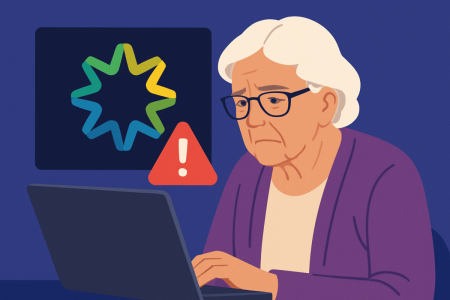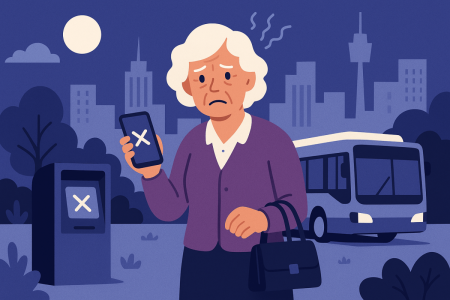Outage Anxiety: Centrelink Crash Leaves Older Aussies in Limbo
- Replies 0
When Centrelink Went Dark
It was a late Thursday night in May when myGov – the online portal to Centrelink and other vital government services – suddenly went dark. Around 10pm AEST, reports trickled in that Australians couldn’t access their Centrelink accounts. What started as a few frustrated posts soon snowballed into a mini-crisis by Friday morning.Older Aussies, many of whom rely on Centrelink for their Age Pension and other payments, woke to find themselves locked out of their accounts. Was it a hack? A system upgrade gone wrong? For users, it hardly mattered – all they saw was error messages and a whole lot of confusion.
Officials later confirmed it was a technical outage, not a cyber attack or anything nefarious. Centrelink’s systems had hit a snag, preventing logins on both the website and the Express Plus Centrelink mobile app. The agency quickly redirected customers with a blunt bit of advice: essentially, sit tight and try again later. Easier said than done. Being told to “please try again later” when you’re worried about your payment is about as comforting as hearing “she’ll be right” while your car breaks down on the freeway.
As one Services Australia spokesperson put it during a past outage, “We apologise for any inconvenience ... and encourage those affected to try again later”. Great – but in the moment, that apology didn’t spare anyone the panic.
Error Messages and Empty Pockets
Australians trying to log in during the outage were greeted with a medley of ominous alerts. Some saw “Service unavailable. Please try again later.” Others got a red banner warning: “Error – There has been a critical system error. Return to myGov and try again”. The website even hit folks with a stark “ACCESS DENIED” page. Imagine being an elderly pensioner, dutifully checking your account for your fortnightly payment, only to see Access Denied in bold letters. Is my account blocked? Have I done something wrong? It’s no surprise that people assumed the worst.DownDetector, a website that tracks online service problems, lit up with hundreds of outage reports. Frustrated Aussies took to social media to vent over the “ridiculous” situation. Was it just me? They soon realized it wasn’t. Half the country is also calling at this very moment, one user remarked, after hitting that access denied loop. The usual troubleshooting – reboot the router, refresh the page, yell at the computer – did nothing. It was a system fault, through and through.
And this wasn’t just a minor inconvenience. For many, it was a potential financial nightmare. “Trying to report our income. MyGov not working, Express Plus app not working. Telephone line screwing up. How are we supposed to report? We need our money tomorrow, we have no food,” one desperate user posted. That heart-wrenching plea sums it up: when Centrelink’s online services fail, people worry they won’t be able to put food on the table. Missed reports can mean delayed payments. For someone living week-to-week on a pension or JobSeeker allowance, a delay can spell real trouble – rent unpaid, bills overdue, an empty fridge.
A Seniors’ Tech Nightmare
For Australians in their 60s and beyond, this outage hit a particularly sensitive nerve. Over the past decade, the government has been nudging everyone – including older citizens – to manage their affairs online. Need to update your details or lodge a form? “Do it on myGov!” Need to ask a question? “Try the website!” Even the pension application has moved online for many. It’s a shift to digital by default. But this assumes a level of tech comfort that isn’t always there for older Australians.In fact, older Aussies are the least digitally included age group in the country. Many seniors didn’t grow up with computers and smartphones, and while plenty have learned the ropes, there’s still a big gap in skills and confidence. Only about 55% of people aged 65 or over use the internet regularly, compared to almost everyone in their 20s and 30s. And even those who do go online often find government websites daunting.
An outage like this one throws a spotlight on those challenges. When the system works, an older Australian can get by – perhaps with help from family or after some training. But when the system doesn’t work, things fall apart quickly. Many seniors don’t have the luxury of switching to a smartphone app or jumping on social media for updates. Some ended up resorting to calling Centrelink’s phone line, only to be met with endless hold music – or worse, that infuriating automated message suggesting they go online instead. (Yes, the irony is rich.)
As one retiree quipped recently, it’s standard these days to be pushed from phone queues to websites, but “this only works if the functionality of the website is up to scratch”. In other words, when the website crashes, so does the entire Plan A for getting stuff done.
Let’s not forget that older Australians make up a huge proportion of Centrelink’s customer base. As of 2023, around 2.8 million people aged 65 and over were receiving some form of income support, and the vast majority – about 2.6 million – rely on the Age Pension. That’s millions of seniors depending on Centrelink to deliver their payments correctly and on time. These folks have paid taxes all their lives and now expect the system to give them a fair go in return. They’re not looking for luxury, just basic reliability. When an outage hits, it undermines that trust and leaves many feeling anxious and powerless.
Real-World Consequences of Going Offline
To some, a few hours of website downtime might sound trivial – just a glitch in the matrix. But for those directly affected, the social consequences are very real. Here are some of the ripple effects a Centrelink outage can have:- Missed or Delayed Payments: If you can’t report your income or satisfy a requirement on time, your payment could be delayed or suspended. While Services Australia often makes allowances for known outages (for example, extending reporting deadlines), people may not always get the message in time. The fear of missing a payment – the money you rely on for rent, medication or groceries – is immediate and visceral.
- Anxiety and Confusion: Not knowing what’s going on is its own trauma. Is it a personal account issue or a system-wide crash? During this May 2025 outage, communication was sparse at first. Many users felt left in the dark. The Department eventually posted updates on platforms like Facebook, but not everyone saw those. The result? Panic. As Services Australia acknowledged in another context, such IT failures cause “confusion and distress” among the public – an apology that rings true for this outage as well.
- Scrambling for Alternatives: When the website and app were down, the only options left were calling the hotline or physically visiting a Centrelink service centre. Phone lines quickly jammed up; some callers reported being on hold for over an hour before giving up. And going in person isn’t always feasible – especially for older folks or those in remote areas. Plus, in this case, the outage struck late at night, so offices were closed. All people could do was wait until morning, then potentially join long queues or extended phone waits.
- Erosion of Trust: Repeated failures in government tech systems chip away at people’s confidence. Many older Australians already approach online services with caution. When they see error messages and can’t get answers, it reinforces the fear that these digital platforms can’t be trusted. That can lead some to avoid using online services in the future, potentially missing out on the convenience and speed those services are supposed to provide.
But the lingering frustration and worry weren’t so easily fixed. As one pensioner friend of mine said over the phone, “I didn’t sleep well, I kept thinking – what if my payment doesn’t come through tomorrow?” For a lot of seniors, that kind of stress isn’t just an emotional burden; it can literally affect their health.
Not the First Rodeo: A History of Government Tech Glitches
Perhaps one of the most frustrating aspects of the May 2025 outage is that it’s hardly unprecedented. We’ve been down this road before – too many times, in fact. Government online services have a track record of crashing at the worst possible moments. A quick trip down memory lane:- MyGov Meltdown of March 2020: As the COVID-19 pandemic hit and Australia went into lockdown, hundreds of thousands rushed to Centrelink for help. The surge in traffic famously crashed the MyGov website. The outage was initially blamed on a supposed cyber-attack, but the Government later admitted it was simply overwhelmed by demand. The sight of massive queues snaking around Centrelink offices – people spaced out in hastily improvised outdoor lines – became an enduring image of 2020. Those were anxious days; some who had never asked for help in their lives suddenly found themselves with no job, no income, and a dead website. The government eventually beefed up server capacity, but not before copping a lot of flak.
- “CensusFail” 2016: Go back a bit further, and you’ll recall the nationwide online Census that infamously failed on launch night. While not a Centrelink issue, it’s another example of a critical government online service going kaput. In that case, the ABS (Australian Bureau of Statistics) shut down the census site, citing a foreign DDoS attack, though the scale of the “attack” was later disputed. The census was eventually completed, but public confidence in government tech took a hit.
- Centrelink Outages in 2018 and 2020: Centrelink’s own systems have buckled under pressure before. In June 2020, for example, an outage stopped people from reporting their income online, throwing error code “E1-0-3” at bewildered users. Social media lit up with complaints, like one user pleading for help because they couldn’t submit their report on time. Similarly, in May 2018, online services went down and even a Telstra network hiccup made things worse. In that instance, officials extended the income reporting deadline to 7pm to ensure no one missed out on their payments – a small silver lining on an otherwise stressful day.
- Late 2024 MyGov Outage: Just a few months before this latest crash, in November 2024, a technical issue locked Australians out of Centrelink, Medicare, and more via MyGov for nearly two days. Over 1,000 outage reports flooded in. Users got the same “access denied” and “critical system error” messages we saw this time around. Services Australia had to post repeated Facebook updates with apologies and assurances that payments wouldn’t be affected. One update noted “most people were still able to report income, and payments are not affected” – likely hoping to calm folks down. But for the people in the thick of it, those words rang hollow, especially as the glitches dragged into a second day. “Frustrating” and “appalling” was how some customers described the experience. The most gut-wrenching feedback came from ordinary Aussies who depend on these services: “We need our money tomorrow… we have no food,” one person tweeted during the 2024 outage. Sound familiar? It’s basically déjà vu in 2025.
Communication Breakdown
One aspect that often gets overlooked in these scenarios is communication. When things go wrong, how effectively does the government get the word out to users? Unfortunately, many older Australians affected by the outage found the communication wanting. Some who phoned Centrelink on Friday morning said they were unaware an outage had occurred at all – they just knew they couldn’t log in. If you weren’t tech-savvy enough to check Twitter or Facebook for announcements, you were basically flying blind.Services Australia did use social media to update the situation (as they have in past outages, posting apologies and status reports), but that assumes people know where to look.
In this case, the outage struck overnight and was resolved by the next day, meaning there wasn’t a press conference or emergency text alert – it was “minor” enough to be handled through online posts. Yet the irony is thick: the government told people about an online outage via online platforms. For the cohort of seniors who don’t use social media regularly, this is a bit like putting the fire evacuation plan in the attic.
Could they do better? Perhaps SMS alerts to those who’ve provided mobile numbers, or a recorded phone message when you dial the Centrelink line (“If you’re calling about login issues, we’re aware and fixing it”). Some affected users suggested that an email could have been sent to all MyGov account holders about the problem. Any proactive communication would be better than silence and leaving people to troubleshoot in the dark. When the MyGov site did display an error, it was a generic one-liner about services being unavailable. There was no direct note like, “Hey, it’s us, not you – we’re working on it.” That human touch was missing.
The lack of timely communication feeds frustration. People start venting on every platform they can find, which in turn spreads misinformation (at one point during the outage, rumours swirled that it might be a cyber hack or that personal details were compromised – none of which was true). Clear, authoritative updates can nip those rumours in the bud.
To their credit, once Services Australia did acknowledge the issue, they assured that no one would be penalized for late reporting and even advised those in hardship to contact them once things were restored. They pledged to help anyone who missed a payment due to not being able to report on time. That’s important – and it should be standard practice. But again, if you didn’t see that message, you wouldn’t know.
The Human Toll and a Call for Change
Beyond the immediate inconvenience, there’s a human toll to these repeated outages that’s harder to measure. It’s the gradual erosion of confidence in our public institutions’ ability to serve us. For older Australians, many of whom have been through decades of societal change, from post-war reconstruction to the digital revolution, there’s a sense of being left behind by technology. They’re told the new way is more efficient – until it isn’t. Each time a failure like this happens, it validates the skepticism of those who say, “See, this is why I don’t trust computers.”It can take a lot of convincing to get a hesitant senior to adopt online banking or myGov in the first place; after an outage, some throw up their hands and decide to stick to the old ways (if any still exist). But what are the old ways now? Waiting on hold for an hour? Lining up at Centrelink at 7am? Those aren’t exactly great options either, especially for someone with health issues or limited mobility.
Socially, there’s also an element of dignity at stake. It can be quite humiliating for a proud older person to suddenly feel at the mercy of a faceless glitch. One day you’re managing your affairs independently online; the next, you’re asking your adult child or a neighbour for help because you can’t log in. Or you’re standing in a queue outside an office feeling like a number. These are intangibles that don’t make the headlines, but they matter.
Technologically, experts argue that the government needs to invest more in robust IT infrastructure and contingency planning. There’s talk of whether Services Australia (which runs Centrelink, Medicare, etc.) is under-resourced or if outdated legacy systems are to blame for some of these failures. Indeed, the government has poured funds into digital transformation projects, but implementation is another story. Every outage is a stark reminder that reliability is just as important as innovation. What good is a flashy new app feature if the whole login system can be taken down by a glitch?
From a policy perspective, one wonders if accountability mechanisms are strong enough. When a private company’s system outage causes customer harm (say, a bank glitch that messes with people’s salaries), there are usually compensations or at least very public apologies and explanations. With government services, apologies do come – but often buried in a Facebook post or a line to a journalist. Rarely do we see officials front up and address the public plainly about what went wrong.
In this latest case, we’re still waiting to hear exactly what caused the outage. Was it a database issue? A failed software update? An overloaded server? Knowing the cause won’t change the past, but it might help reassure people that the root problem has been addressed so it won’t happen again. Silence, on the other hand, can breed suspicion that nothing’s being done and that we’re doomed to repeat the chaos in a few months.
And let’s talk about support. When the systems fail, support for users must kick in. During the 2024 incident, Services Australia extended phone line hours and urged anyone in hardship to reach out so they could get emergency funds if needed. That’s a good practice – effectively having a manual backup process when the digital process collapses. Did that happen this time? It appears the outage was short enough that most payments weren’t disrupted, but if it had lasted, one would hope similar measures would be enacted (e.g., automatically extending reporting due dates, or proactively sending payments through based on last known information).
Finally, there’s a broader social question: Are we moving too fast in shifting essential services online without adequate safeguards? Australia’s push to digital government has many benefits – convenience, efficiency, cost-saving. But incidents like these highlight the risks of putting all our eggs in the digital basket without keeping strong safety nets. Particularly for older Australians and other vulnerable groups, a purely digital service model can feel like walking a tightrope without a net.
So, what’s the takeaway from the great Centrelink Crash of May 2025? In a nutshell: we need our technology to be reliable and humane. It’s not enough to build a whiz-bang system; we have to consider the people at the end of it. That means designing systems that rarely fail, and when they do fail (because nothing is 100% perfect), ensuring people aren’t left high and dry. It means communicating quickly and clearly, so a grandmother in Wagga Wagga isn’t up all night worrying if she accidentally pressed the wrong button to cause her account to lock up. It means having backup plans for those who can’t use the digital service, and not penalizing anyone for the system’s mistakes.
As the dust settles from this outage, there will be the usual reviews and promises. But Australians – especially our seniors – deserve more than routine. They deserve a system that actually learns from its errors. Maybe it’s time our government tech underwent the same kind of rigorous testing and oversight that we expect of other critical services. Because whether you’re 25 or 75, when you depend on a payment to survive, downtime is a big deal.
In the end, this incident is about more than a computer glitch; it’s about trust and peace of mind. We often hear that the future is digital, and indeed it is. But that future has to include everyone, young and old, and it has to work even when things go wrong. The power went out at Centrelink for a night – metaphorically speaking – and it shone a light on all the cracks in the system. The real test will be whether we fix those cracks before the next outage strikes.
Now, a question to ponder: As we barrel towards a fully digital future, how can we ensure that no Australian – especially our most vulnerable seniors – is left stranded when our high-tech systems suddenly fail us?









